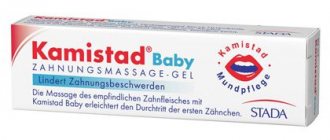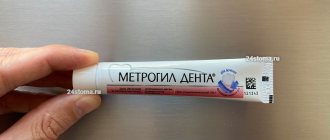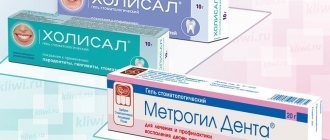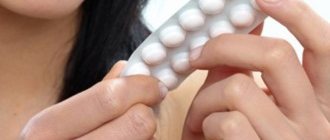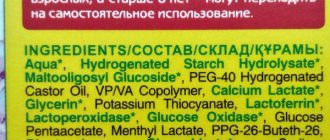Everyone experiences dental disease at some point. But more often, problems with teeth appear in pregnant women. The reasons are increased stress on the body, rapid consumption of calcium reserves necessary for the construction of the baby’s skeletal system. Many medications are prohibited during pregnancy. Doctors know what to do in such a situation. Dentists often prescribe Metrogyl denta to their patients, the instructions for pregnancy state that the drug can be used during the 2nd or 3rd trimester, but with caution.
Description of the drug
Metrogyl Denta is produced by an Indian pharmaceutical company that uses Ayurvedic knowledge when developing its drugs.
The release form of the medicine is a white gel with a faint menthol odor. The basic components of the product are chlorhexidine and metronidazole. Additional components:
- Sodium hydroxide
- Levomenthol
- Saccharin
- Carbopol
- Water
- E 1520.
Metrogyl Denta is an antimicrobial and antiseptic drug. When applied topically, the gel is almost not absorbed and does not penetrate into the general bloodstream.
The antibiotic effectively destroys gram-negative and gram-positive microorganisms. However, the drug does not disrupt the microflora in the mouth. Therefore, the number of lactobacilli does not decrease.
Metrogyl denta is prescribed for the following diseases:
- Periodontitis is inflammation of the periodontium, leading to the appearance of a pocket in the gum and destruction of the bone process
- Gingivitis – occurs due to hormonal imbalance, lack of vitamins in pregnant women
- Aphthous stomatitis - the disease is characterized by the formation of aphthae, the ulcers hurt and take a long time to heal
- Cheilitis – characterized by the formation of ulcerations, crusts, and redness in the corners of the mouth
- Periodontitis – inflammation and suppuration of the periodontium
- Periodontal disease is a lesion of the tissues that fix the tooth, which exposes the neck of the tooth.
Doctors know whether Metrogyl denta gel can be used topically for dental diseases by pregnant women. But contraindications should be taken into account. These are intolerance to components, age under 18 years, diseases of the central nervous system or blood, 1st trimester of pregnancy.
Using Metrogyl may lead to side effects. Often, after using the gel, allergic manifestations and headaches appear.
Is it possible to treat teeth during pregnancy?
Most likely, the tooth will decay during this time (the bulk of the minerals go to build the fetal body), damage neighboring ones, and also become a source of infection for the newborn. Let's add a change in the properties of saliva, which, due to its increased viscosity, cannot fully wash and protect teeth, and weak mineralization.
The answer is clear: treat. To do this, you need to choose the right time, place, specialist and materials. The specialists at SM-Dentistry treat their patients very carefully and choose only safe treatment methods.
Is it possible during pregnancy?
Doctors know whether pregnant women can use Metrogyl dent. The product contains an antibiotic, so doctors advise using it with caution.
Metrogyl denta should not be applied to the oral mucosa during pregnancy. But there are a number of cases prohibiting the use of the gel during this period:
- Intolerance to the components of the product
- The development of allergic reactions in the form of itching, nettle fever, headache and rashes.
Recommendations for use boil down to the fact that the medicine can be used topically, applied only to the affected areas of soft tissue. A little gel is squeezed onto a cotton swab and then smeared on the damaged areas.
The procedure is carried out twice a day. After applying the antiseptic, you should not eat for the next 30 minutes. Duration of therapy – 7 days.
If Metrogyl denta is used for periodontitis, then first you need to clean the diseased areas of the gums. The therapeutic effect of the gel lasts about half an hour.
For aphthous stomatitis, treatment lasts up to 10 days. For chronic dental problems, therapy is carried out every year for a course of 7-10 days. The gel can also be used to treat wounds formed after tooth extraction.
Instructions for use
In the later stages of pregnancy, the dentist prescribes it when infectious and inflammatory pathologies of the mouth are detected. A woman should not ignore medical recommendations. Any untreated infection will cause symptoms of general intoxication of the body. Such an action will negatively affect the intrauterine growth and development of the fetus and harm the health of the mother.
The duration of therapy recommended during pregnancy in the instructions for use of Metrogyl Denta is 5-14 days. When carrying a child, the drug is prescribed for the shortest possible time and in low doses . This helps minimize the likelihood of side effects. Breastfeeding should be discontinued during treatment with dental gel.
Indications and contraindications
A contraindication to the use of Metrogyl Denta during pregnancy is intolerance to the active or auxiliary ingredients. Also, it cannot be used to prevent gingivitis and other dental pathologies. The gel is prescribed to patients when diagnosing the following periodontal diseases:
- Vincent's ulcerative necrotic gingivitis;
- post-extraction alveolitis;
- acute or chronic periodontitis.
The drug is used to treat cheilitis - inflammation that affects the red border, mucous membrane and skin of the lips. It quickly destroys infectious agents of stomatitis, especially its aphthous form.
Scheme of use during pregnancy
From the second trimester of pregnancy, a thin layer of Metrogyl Dent should be applied to the gums in the morning and evening. The procedure should be carried out only with clean hands using a cotton pad or swab.
After application, you should refrain from eating food and water for 30-40 minutes.
If periodontitis is detected during pregnancy, then Metrogyl Denta gel is used after cleaning the tartar. The dentist will show the woman how to treat a periodontal pocket. In the future, she carries out the procedure independently at home. The average duration of use is 7-10 days.
Side effects
In the second and third trimesters of pregnancy, the use of Metrogyl Denta may cause the development of allergies. Clinically, it manifests itself in the form of small rashes, itching, swelling and redness of the skin.
Metrogyl denta dental gel for gums 20g
Registration number
P N015982/01
Trade name
Metrogyl Denta®
International nonproprietary or generic name
Metronidazole + Chlorhexidine
Dosage form
dental gel
Compound
1 gram of gel contains:
active ingredients: metronidazole benzoate 16.0 mg (equivalent to metronidazole 10.0 mg), chlorhexidine digluconate 20% solution 2.5 mg (equivalent to chlorhexidine digluconate 0.5 mg).
excipients: propylene glycol 50.0 mg, carbomer-980 15.0 mg, disodium edetate 0.5 mg, saccharin 1.0 mg, levomenthol 5.0 mg, sodium hydroxide 4.0 mg, water up to 1 g.
Description
white or off-white opalescent soft gel
Pharmacotherapeutic group
Antimicrobial agent
ATX code A01AB11
Pharmacological properties
The effectiveness of the drug is due to the presence of two antibacterial components in its composition:
a) metronidazole has an antibacterial effect against anaerobic bacteria that cause periodontal diseases: Porphyromonas gingivalis, Prevotella intermedia, Fusobacterium fusiformis, Wolinella recta, Eikenella corrodens, Borrelia vincenti, Bacteroides melaninogenicus, Selenomonas spp.
b) chlorhexidine is an antiseptic and antimicrobial agent, effective against gram-positive and gram-negative aerobic and anaerobic bacteria (Treponema spp., Neisseria gonorrhoeae, Trichomonas spp., Chlamydia spp., Ureaplasma spp., Bacteroides fragilis). Some strains of Pseudomonas spp., Proteus spp. are weakly sensitive to the drug, and acid-resistant forms of bacteria and bacterial spores are also resistant. Does not interfere with the functional activity of lactobacilli. When applied topically, Metrogyl Denta gel is practically not absorbed.
Indications for use
Infectious and inflammatory diseases of periodontal and oral mucosa:
- acute and chronic gingivitis;
- acute ulcerative-necrotizing gingivitis of Vincent;
- acute and chronic periodontitis;
- juvenile periodontitis;
- periodontal disease complicated by gingivitis;
- aphthous stomatitis;
- cheilitis;
- inflammation of the oral mucosa when wearing dentures;
- post-extraction alveolitis (inflammation of the socket after tooth extraction);
- periodontitis, periodontal abscess (as part of combination therapy).
Contraindications
- hypersensitivity to metronidazole, chlorhexidine, nitroimidazole derivatives or other components of the drug;
- diseases of the blood system, including a history;
- diseases of the peripheral and central nervous system;
- children under 18 years of age.
Use during pregnancy and breastfeeding
Due to the lack of clinical data, the safety of the drug during pregnancy and breastfeeding has not been established. The use of the drug during pregnancy is not recommended. During the period of breastfeeding, if it is necessary to prescribe the drug, the issue of stopping breastfeeding should be decided.
Directions for use and doses
Topically, for dental use only.
For inflammation of the gums (gingivitis):
Metrogyl Denta® is applied to the gum area with a thin layer with your finger or with a cotton swab 2 times a day.
After applying the gel, you should refrain from drinking and eating for 30 minutes.
It is not recommended to wash off the gel. The duration of treatment is on average 7-10 days.
For periodontitis:
After removing dental plaque, periodontal pockets are treated with Metrogyl Denta® gel, and the gel is applied to the gum area.
Exposure time – 30 min. The number of procedures depends on the severity of the disease.
In the future, the patient can apply the gel independently. Metrogyl Denta® is applied to the gum area 2 times a day for 7-10 days.
For aphthous stomatitis:
Metrogyl Denta® is applied to the affected area of the oral mucosa 2 times a day for 7-10 days.
To prevent exacerbations of chronic gingivitis and periodontitis:
Metrogyl Denta® gel is applied to the gum area 2 times a day for 7-10 days.
Preventive courses of treatment are carried out 2-3 times a year.
To prevent post-extraction alveolitis:
after tooth extraction, the hole is treated with Metrogyl Denta® gel, then the gel is applied 2-3 times a day for 7-10 days.
Side effect
When using the drug Metrogyl Denta® topically, dental gel, allergic reactions (skin rash, itching, urticaria, anaphylactic reactions, including anaphylactic shock), as well as headache, may occur.
Overdose
Accidental or intentional ingestion of a large amount of gel may cause increased side effects, mainly caused by metronidazole (chlorhexidine is practically not absorbed from the gastrointestinal tract).
The following may be observed: nausea, vomiting, dizziness, and in more severe cases – paresthesia and convulsions.
Treatment:
gastric lavage, symptomatic therapy if necessary.
Interaction with other drugs
When applied topically in recommended doses, no systemic interaction of MetrogilDent® gel with other drugs was detected.
special instructions
The use of Metrogyl Denta® does not replace hygienic brushing of teeth, therefore, during the course of treatment with the drug, teeth brushing should be continued.
The drug should be stored out of the reach of children.
If the drug is accidentally or intentionally swallowed by a child, seek immediate medical attention.
If the medicine has become unusable or has expired, do not throw it into wastewater or onto the street!
Place the medication in a bag and place it in the trash. These measures will help protect the environment!
Impact on the ability to drive vehicles and other mechanisms
There is no information on the effect of the drug on the ability to drive vehicles and engage in other potentially hazardous activities that require increased concentration and speed of psychomotor reactions.
Release form
Dental gel.
5 g, 10 g or 20 g in a plastic laminated tube, the neck of which is sealed with aluminum foil, laminated with polyethylene and with a screw cap made of polypropylene.
One tube in a cardboard box with instructions for use.
5 g, 10 g or 20 g in a plastic laminated tube, the neck of which is sealed with aluminum foil laminated with polyethylene and with a polypropylene screw cap with a protrusion for perforating the foil.
One tube in a cardboard box with instructions for use.
Storage conditions
At a temperature not higher than 25 C.
Keep out of the reach of children.
Best before date
3 years.
Do not use after expiration date.
Vacation conditions
Over the counter.
Dental prevention during pregnancy
- Treatment of carious teeth and periodontitis before pregnancy.
- Careful dental and oral care. In addition to mandatory brushing of teeth 2 times a day with high-quality toothpaste, it is recommended to use dental floss and rinse to prevent gum disease. You can use gels that restore enamel mineralization, reduce sensitivity and stop caries in the early stages.
- Nutrition should be complete; you can supplement it with vitamin and mineral complexes on the recommendation of the obstetrician-gynecologist who is managing the pregnancy and your trusted dentist.
- Preventive examinations in every trimester. Professional cleaning is usually carried out 2 times a year.
Finding your dentist is no less important than finding a gynecologist. When you trust a specialist, any manipulation will be easy and positive, which will definitely have a positive effect on the health of both mother and child.

